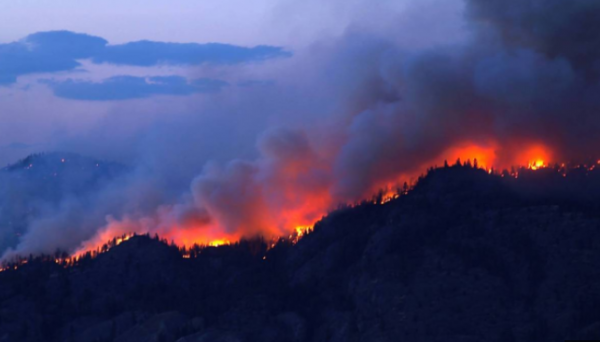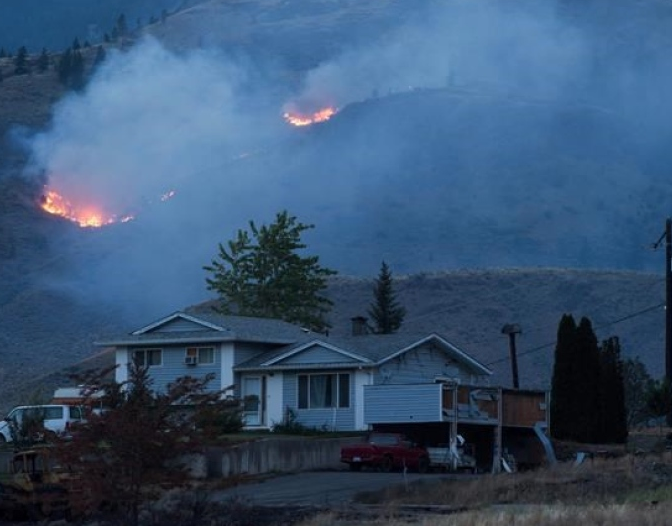
Wildfires Linked to Climate Change?

Fire threatens a home on Ashcroft First Nation. THE CANADIAN PRESS/Darryl Dyck
Wildfires are sweeping B.C. Close to 900 have burned through 600,000 hectares so far this year, blanketing western North America with smoke. Fighting them has cost more than $230 million—and the season is far from over.
It’s not just B.C. Thousands of people from B.C. to California have fled homes as fires rage. Greenland is experiencing the largest blaze ever recorded, one that Prof. Stef Lhermitte of Delft University in the Netherlands called “a rare and unusual event”. Fires have spread throughout Europe, North America, and elsewhere. In June, dozens of people died in what’s being called Portugal’s worst fire ever. Meanwhile, from Saskatchewan to Vietnam to New Zealand, floods have brought landslides, death, and destruction.
David Suzuki, scientist, broadcaster, author, and co-founder of the David Suzuki Foundation. ties these events with a common environmental thread: climate change.
“What will it take to wake us up to the need to address climate change? Fires and floods have always been here, and are often nature’s way of renewing ecosystems—but as the world warms, they’re increasing in frequency, size, and severity. Experts warn that wildfires could double in number in the near future, with the Pacific Northwest seeing five or six times as many,” writes Suzuki in a recent article.
In the western U.S., annual average temperatures have increased by two degrees Celsius and the fire season has grown by three months since the 1970s, leading to a “new era of western wildfires”, according to a recent study led by University of Colorado Boulder wildfire experts and published in Proceedings of the National Academy of Sciences.
Climate change doesn’t necessarily start the fires—lightning, unattended campfires, carelessly tossed cigarette butts, and sparks from machinery are major causes—but it creates conditions for more and larger fires. Lightning, which causes up to 35 percent of Canada’s wildfires and is responsible for 85 percent of the area burned annually, increases as temperatures rise, with studies showing 12 percent more lightning strikes for each degree Celsius of warming.
Drier, shorter winters and earlier snowmelt extend fire seasons. As the atmosphere warms, it holds more moisture, some of which it draws from forests and wetlands, and increasing precipitation is not enough to offset the drying. This means fuel sources ignite more easily and fires spread faster over greater areas. Outbreaks of pests such as mountain pine beetles—previously kept in check by longer, colder winters—have also killed and dried forests, adding fuel to the fires. Because trees and soils hold moisture on slopes, fires can also increase the risk of flash floods when rains finally arrive.
Suzuki points out that the human and economic impacts are staggering—from property destruction to firefighting and prevention to loss of valuable resources and ecosystems. As human populations expand farther into wild areas, damages and costs are increasing.
Health impacts from smoke put people—especially children and the elderly—at risk and drive health-care costs up. Wildfires now kill more than 340,000 people a year, mainly from smoke inhalation.
Fires also emit CO2, creating feedback loops and exacerbating climate change. Boreal forests in Canada and Russia store large amounts of carbon and help regulate the climate, but they’re especially vulnerable to wildfires.
Suggested solutions are wide-ranging. The authors of the PNAS study recommend letting some wildfires burn in areas uninhabited by people, setting more “controlled” fires to reduce undergrowth fuels and create barriers, thinning dense forests, discouraging development in fire-prone areas, and strengthening building codes.
These adaptive measures are important, as are methods to prevent people from sparking fires, but Suzuki argues our primary focus should be on doing all we can to slow global warming.
Suzuki cites NASA data indicating the Earth’s average surface temperature has risen by 1.1-degrees C since the late 19th century, with most warming occurring over the past 35 years, with 16 of the 17 warmest years occurring since 2001. Eight months of 2016 were the warmest on record. Oceans have also been warming and acidifying quickly, Arctic ice has rapidly decreased in extent and thickness; glaciers are retreating worldwide; and sea levels have been rising at an accelerating pace. Record high-temperature events have been increasing while low-temperature events have decreased, and extreme-weather events are becoming more common in many areas.
Today’s wildfires, concludes Suzuki, are a wake-up call.
